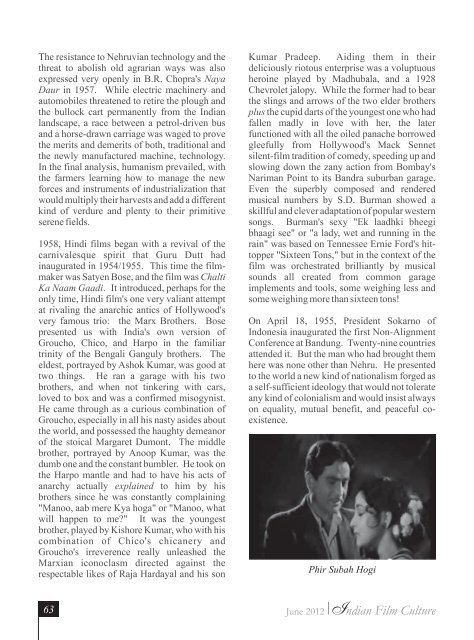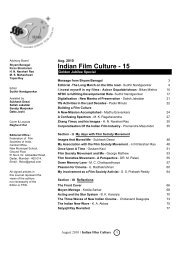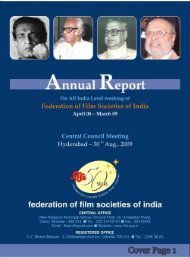Indian Film Culture - 16.cdr - federation of film societies of india
Indian Film Culture - 16.cdr - federation of film societies of india
Indian Film Culture - 16.cdr - federation of film societies of india
Create successful ePaper yourself
Turn your PDF publications into a flip-book with our unique Google optimized e-Paper software.
The resistance to Nehruvian technology and the<br />
threat to abolish old agrarian ways was also<br />
expressed very openly in B.R. Chopra's Naya<br />
Daur in 1957. While electric machinery and<br />
automobiles threatened to retire the plough and<br />
the bullock cart permanently from the <strong>Indian</strong><br />
landscape, a race between a petrol-driven bus<br />
and a horse-drawn carriage was waged to prove<br />
the merits and demerits <strong>of</strong> both, traditional and<br />
the newly manufactured machine, technology.<br />
In the final analysis, humanism prevailed, with<br />
the farmers learning how to manage the new<br />
forces and instruments <strong>of</strong> industrialization that<br />
would multiply their harvests and add a different<br />
kind <strong>of</strong> verdure and plenty to their primitive<br />
serene fields.<br />
1958, Hindi <strong>film</strong>s began with a revival <strong>of</strong> the<br />
carnivalesque spirit that Guru Dutt had<br />
inaugurated in 1954/1955. This time the <strong>film</strong>maker<br />
was Satyen Bose, and the <strong>film</strong> was Chalti<br />
Ka Naam Gaadi. It introduced, perhaps for the<br />
only time, Hindi <strong>film</strong>'s one very valiant attempt<br />
at rivaling the anarchic antics <strong>of</strong> Hollywood's<br />
very famous trio: the Marx Brothers. Bose<br />
presented us with India's own version <strong>of</strong><br />
Groucho, Chico, and Harpo in the familiar<br />
trinity <strong>of</strong> the Bengali Ganguly brothers. The<br />
eldest, portrayed by Ashok Kumar, was good at<br />
two things. He ran a garage with his two<br />
brothers, and when not tinkering with cars,<br />
loved to box and was a confirmed misogynist.<br />
He came through as a curious combination <strong>of</strong><br />
Groucho, especially in all his nasty asides about<br />
the world, and possessed the haughty demeanor<br />
<strong>of</strong> the stoical Margaret Dumont. The middle<br />
brother, portrayed by Anoop Kumar, was the<br />
dumb one and the constant bumbler. He took on<br />
the Harpo mantle and had to have his acts <strong>of</strong><br />
anarchy actually explained to him by his<br />
brothers since he was constantly complaining<br />
"Manoo, aab mere Kya hoga" or "Manoo, what<br />
will happen to me?" It was the youngest<br />
brother, played by Kishore Kumar, who with his<br />
combination <strong>of</strong> Chico's chicanery and<br />
Groucho's irreverence really unleashed the<br />
Marxian iconoclasm directed against the<br />
respectable likes <strong>of</strong> Raja Hardayal and his son<br />
63<br />
Kumar Pradeep. Aiding them in their<br />
deliciously riotous enterprise was a voluptuous<br />
heroine played by Madhubala, and a 1928<br />
Chevrolet jalopy. While the former had to bear<br />
the slings and arrows <strong>of</strong> the two elder brothers<br />
plus the cupid darts <strong>of</strong> the youngest one who had<br />
fallen madly in love with her, the later<br />
functioned with all the oiled panache borrowed<br />
gleefully from Hollywood's Mack Sennet<br />
silent-<strong>film</strong> tradition <strong>of</strong> comedy, speeding up and<br />
slowing down the zany action from Bombay's<br />
Nariman Point to its Bandra suburban garage.<br />
Even the superbly composed and rendered<br />
musical numbers by S.D. Burman showed a<br />
skillful and clever adaptation <strong>of</strong> popular western<br />
songs. Burman's sexy "Ek laadhki bheegi<br />
bhaagi see" or "a lady, wet and running in the<br />
rain" was based on Tennessee Ernie Ford's hittopper<br />
"Sixteen Tons," but in the context <strong>of</strong> the<br />
<strong>film</strong> was orchestrated brilliantly by musical<br />
sounds all created from common garage<br />
implements and tools, some weighing less and<br />
some weighing more than sixteen tons!<br />
On April 18, 1955, President Sokarno <strong>of</strong><br />
Indonesia inaugurated the first Non-Alignment<br />
Conference at Bandung. Twenty-nine countries<br />
attended it. But the man who had brought them<br />
here was none other than Nehru. He presented<br />
to the world a new kind <strong>of</strong> nationalism forged as<br />
a self-sufficient ideology that would not tolerate<br />
any kind <strong>of</strong> colonialism and would insist always<br />
on equality, mutual benefit, and peaceful coexistence.<br />
June 2012<br />
Phir Subah Hogi<br />
<strong>Indian</strong> <strong>Film</strong> <strong>Culture</strong>





